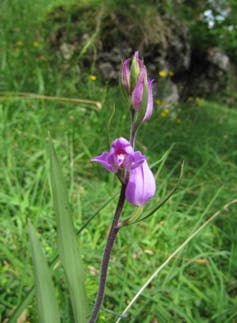The green plants that feed on fungi
 Cephalanthera rubra, a partially mycoheterotrophic orchid. Nicole Hynson
Cephalanthera rubra, a partially mycoheterotrophic orchid. Nicole HynsonCompetition among plants for resources like water, light and nutrients can be intense. Unlike most living things, plants are basically immobile, stuck in the place where they’re rooted. They don’t have legs to escape unpleasant conditions. They can’t run after prey or head to the store when they’re hungry. Because of this rootedness, plants have come up with some intriguing adaptations for making a living, one of which is known as “mycoheterotrophy” or “fungus-feeding.”
Nicole Hynson, a new faculty member at SOEST’s Pacific Biosciences Research Center, studies the ecology of plant and fungal communities, especially the symbiosis between plants and fungi known as mycorrhizae.
The majority of land plant families form mutually beneficial partnerships with root-inhabiting fungi known as mycorrhizal fungi. But some plants have evolved to cheat this mutualism. They don’t provide any known return benefits – such as carbohydrates derived from photosynthesis – to their fungal partners. Instead, these mycoheterotrophic plants receive both carbohydrates and other nutrients from their mycorrhizal partners, subverting the need to compete with neighboring plants for resources.
This selfish kind of symbiotic relationship between plants and fungi was a surprising revelation for botanists and adds some nuance to our basic understanding of how plants make a living.
The Hynson Lab is using stable carbon isotopes to learn more about how these relationships work.
Read more in The Conversation.




